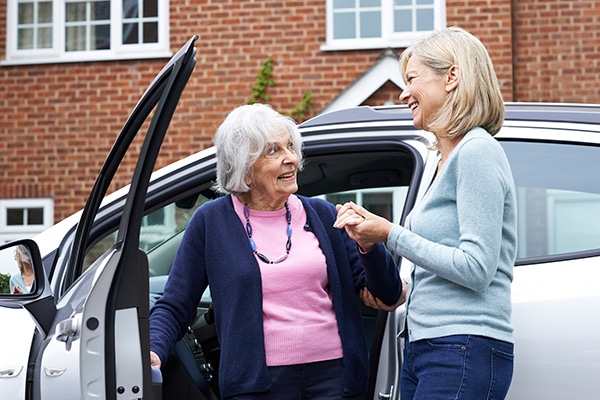Introduction
Outings are part of resident activities, giving them supervised access to the world outside their home! Some care homes and supported living homes will have access to a mini-bus to facilitate travel to the shops, days out etc. However, smaller journeys may be carried out by a member of staff or a volunteer using their personal car, where a pool car is not available. The safety of our residents is paramount as well as that of the staff who drive. Having the correct measures in place to protect residents, staff and volunteers is important for the safe and smooth running of our homes.
Do My Staff And Volunteers Need Business Insurance?
Whilst staff and volunteers don’t need business insurance to travel to and from work, when they engage in business activities such as taking a resident to the GP, out to the shops or on an outing to a public garden, they need to have business insurance in place. It is important that insurers are fully aware of the type of activities that staff are engaged in and that this is stated in the policy document.
What Else Do I Need to Check With Staff?
Any member of staff driving a vehicle must first have to have passed a driving test and have a full licence for the type of vehicle they drive. It is important to check their driver’s card ie: if they can only drive an automatic car then driving a manual car is illegal as they have not passed their test in a manual car.
Other things to check for:
- Expiry date on the driving licence
- MOT certificate if over 3 years old
- Car tax to drive on public highways. This can be checked at www.gov.uk/vehicle-tax
- The details match the person driving the car
- Have they had any endorsements (points on their licence)?
- Is the licence valid or have they been disqualified?
- The vehicle service records
Staff can find out what is on their driving licence by going to the government website. As an employer, you can request access to a staff member’s driving details to assess if they can legally drive a vehicle for work. To verify a licence and its details visit Gov.UK Verify.
What Should Be In A Staff Car For Resident Outings?
No one wants to break down or lose their direction when driving a car, so it is important to be prepared before using your car for escorting residents on outings. A few suggestions might be:
- Having a first aid kit in the car – your employer should provide you with a travel first aid kit and an accident book for this purpose. Don’t forget some sick trays, kitchen roll and yellow clinical waste sacks for longer journeys
- Bottled water in case you and your resident (s) get thirsty
- In winter have a shovel and a couple of old pieces of carpet in case you get stuck in the snow. Also, carry a couple of blankets or a foil suit to keep warm if you break down
- A charged mobile phone and a list of contact numbers
- A small amount of loose change
- A sat-nav or map and a print out of directions if you are not familiar with the journey
- A hi-vis vest or jacket if you break down
Are Pre-journey Car Checks Necessary And What Should Be Checked?
Some companies have pre-journey checklists which staff complete prior to using their own car for work reasons. Whilst it is not a legal requirement to have a checklist, all cars must be roadworthy and thus not cause danger to others by their condition. There are a few basics which should be on a checklist:
- Car make, model and registration number
- Date of journey and its destination including times and route of travel
- Name of the driver and list of residents travelling
Observation checks on the vehicle could be:
- Is the tyre pressure correct?
- Do tyres have the correct tread?
- Do all lights and warning indicators work?
- Does the handbrake or electronic brake work?
- Is the oil level correct?
- Is the window washer level correct?
- Do all doors/boot shut properly?
- Is anything not secure ie: no loose bumper etc?
Show Me The Legislation!
Whilst everyone who drives a vehicle on the public highway has to abide by the road traffic legislation, when a vehicle is used for work purposes, even if it is your own vehicle, there are other considerations.
Under “The Health and Safety at Work Act 1974” section 3 (1) the act cites the following:
“It shall be the duty of every employer to conduct his undertaking in such a way as to ensure, so far as is reasonably practicable, that persons not in his employment who may be affected thereby are not thereby exposed to risks to their health or safety.”
Reference to people not in the person’s employment – this would be the resident who is being taken to an appointment or for a visit, as the actions of the driver, who is employed by the company: ie carer/support worker could put the resident at risk if their vehicle was unsafe or they drove it irresponsibly.
Do I Need A Risk Assessment?
Under “The Management of Health and Safety at Work Regulations 1999” section 3 (1) it states the following:
(1) Every employer shall make a suitable and sufficient assessment of—
(a) the risks to the health and safety of his employees to which they are exposed whilst they are at work; and
(b) the risks to the health and safety of persons not in his employment arising out of or in connection with the conduct by him of his undertaking.
Any activity which involves a member of staff taking out a resident should be risk assessed based on the activity and its environment. It should also take account of any risks of the resident which should be documented in their care plan. As said many times, a risk assessment must state which control measures are in place to manage the risk.
Summary
Owners and managers of social care establishments need to ensure the correct checks and balances are in place to ensure that staff are safe to drive a car for work and they have the correct documentation to prove they can legally drive and the vehicle is maintained correctly. Risk assessments are an essential part of managing risk of harm to residents, staff and those who could be affected by the actions of a driver.
References:
HSE – Employers Responsibilities
HSE – Practical Considerations
Gov.UK – Tax Your Vehicle
Gov.UK – View and share your driving licence information
Gov.UK – Verify a licence
Health and Safety at Work Act 1974 section 3 (1)
The Management of Health and Safety at Work Regulations 1999 section 3 (1)







